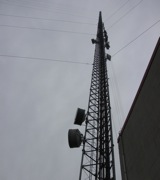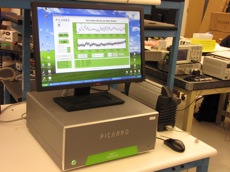
A companion radio piece to this post aired on The California Report.
Scientists in California have begun setting up a statewide network of monitors to track California’s greenhouse gas emissions. Similar equipment has been in place for years as part of a continental network established by the National Oceanic & Atmospheric Administration (NOAA). But officials at the California Air Resources Board (CARB) say this new system will be the first of its kind.
“The unique thing about this is that we’re actually looking at the local emissions, rather than the global average, says Jorn Herner, who heads the Greenhouse Gas Technology & Field Testing Section of CARB’s research arm. “Nobody has done that before.”
Scientists have been systematically tracking atmospheric CO2 on a broad scale since 1958. California’s network of GHG sniffers will be capable of tracking CO2, nitrous oxides and other known greenhouse gases, and will initially focus on methane.
But CARB officials say the network is not part of a “Big Brother” strategy for emissions compliance. “This is initially a research project,” said Herner. He says the new network will provide a “second data point” to augment the state’s current method of estimating GHG emissions. Currently California’s current climate law, AB-32, relies on a “bottom-up” system of estimating emissions from individual sources, then adding them up to arrive at total emissions for the state.
“The modeling won’t tell you each individual source but what you’d be able to do is develop a gridded inventory. So you’ll be able to say in this square mile of land over here, it looks like emissions are much higher than in this square mile next to it.”

The Air Board has purchased seven “next-generation” analyzers from Picarro Instruments in Sunnyvale. Five will go to fixed locations, such as a tower on Mt. Wilson, above the Los Angeles Basin. The two others will be on “mobile platforms;” electric vehicles that can roam the state taking ground-level readings. The units cost about $50,000 apiece but Picarro executives say they are self-adjusting and require far less human intervention than previous models, which will ultimately make them more cost-effective.
Picarro’s CEO, Michael Woelk, says a nationwide network of 500-to-700 detectors could yield a comprehensive GHG map of the US with resolution down to ten kilometers (a little more than six miles).
If California regulators are successful at putting in place a statewide or regional cap-and-trade system for greenhouse gases, industrial emitters will have to pay fees for the carbon they pump into the air. Horn agrees that at that point, some kind of check on the current system of self-reporting will “probably” be needed, but, he says, “that’s not the goal of this monitoring network at this time.”
“The science is really young,” he explained. “We’re really just trying to find out the potential of what we can do with this network. How it’s used in the future is still up in the air.”
…so to speak.
This animation below shows the methane levels detected by a Picarro analyzer as it is driven from Livermore, CA, to Sacramento.
4 thoughts on “Air Board: GHG Sniffers for Research, Not Enforcement”
Comments are closed.

The press release reads:
“The modeling won’t tell you each individual source but what you’d be able to do is develop a gridded inventory. So you’ll be able to say in this square mile of land over here, it looks like emissions are much higher than in this square mile next to it.”
CARB also measures and models Ozone, but in an investigation by the Sierra Environmenal Studies Foundation it was discovered that the CARB models leave a lot to be desired in terms of accuracy and validity. And extract from section 2:
2 Modeling Ozone Pollution
2.1 General Problems and Current Shortcomings
Two revealing reports from government agencies have been written recently that allow us to put the O3 modeling issue into perspective. In ‘A Major Challenge in Meteorological Model Evaluation for Air Quality’ Bao and Michelson [1] have outlined in detail the major problems which remain with designing and building computer models that explain and predict ozone levels over large areas containing complex terrain and even more complex air flows. These scientists from NOAA and the University of Colorado (CIRES), both located in Boulder, Colorado, have concluded in a carefully worded report that there is yet so much work to be done that the state of the current models represents only the beginning of a much longer journey to understanding how ozone pollution behaves in the real world.
Specifically, they report that all aspects of such air quality models are poorly understood and/or unconfirmed. The fundamental physics of involved airflows that determine how and where the ozone spreads are unknown.
Since CO2 is also a gas, Can we assume the same problems exist with the green house gas models as well. It would be nice to know, that CARB is doing a better job with greenhouse gases than they are with Ozone.
The full report can be found here:
http://sesfoundation.org/reports.htm
See Title: Foothill Furor – Seeking Basis for Public Policy on Ozone Pollution Read Section 2.
Russel, good comment. Give me shout if you want to discuss the technology further. One point in this regard — CARB is only now starting to look at atmospheric measurements of methane and other GHGs. Everyone knows that modeling technology is in its infancy and with actual in situ monitors running, combined with wind data, the models that will be constructed should be far more robust than existing models for GHGs, which are largely self-reported or based on software calculations that rely entirely on human estimates. So even if existing models based on measurements are not perfect, they are certainly better than the alternative which is no measurements and relying on emitters to report their emissions. An increasing number of studies have found that these sorts of bottom-up GHG accounting models can underestimate emissions by significant amounts. Again, very happy to discuss further.
I’d like to clarify that what appears on our blog is not a “press release,” nor was any portion taken from one. The quote that Russ lifted is from my own interview with Jorn Herner and three other representatives from CARB, last week.
We will occasionally quote from press releases but when we do, we make a point of clearly attributing those quotes.
My error, the text looked a press release I had seen some where. Sorry for my mistake.